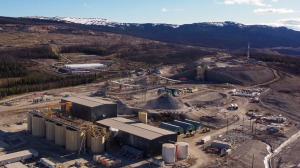Ground was broken recently for a building that just might be the future of urban farming.
It’s a vertical greenhouse that will rise 17 storeys in the small city of Linköping, in southern Sweden. And there is almost nothing about it that isn’t unique, including ownership.
With about seven billion people in the world now, and predictions of another two billion by 2050, thoughtful people the world over are concerned about security of food supplies. Given the absence of leadership by our politicians, others are stepping in to fill the void and beginning to do something to ensure that future generations might eat.
Linköping is a city of just over 100,000, with an environmentally aware population and a thriving high-tech industry. The thinking is that the new vertical farm will be able to produce enough fresh fruits and vegetables to feed the city, except, of course, for more exotic foodstuffs people may choose to import.
The building will be a dream for specialty contractors. The glazing contract alone will be huge. So will the special mechanical systems that will be needed.
The building will be a conical glass structure built around a central helix that will carry the pots containing fruits and vegetables slowly around the spiral, up and down the building. The individual pots will also rotate as they travel; ensuring that all sides of each plant receives adequate light.
Efforts to produce vegetables in greenhouses on a large scale year-round have failed in the past in many countries, foundering on high energy costs. But the Swedish building will take advantage of “spillage heat” from a nearby power plant that generates both heat and electricity by burning biogas derived from biowaste, which often has surplus unsold energy.
The company building the structure is Plantagon International SA, which offers several designs for other vertical farms. Some are free-standing, but scaled for larger or smaller cities. Others are designs for integrating a vertical farm on one side of otherwise ordinary-looking office or apartment towers. But all employ the idea of the central helix to give all plants adequate light.
The smallest of the designs is a five-storey globular greenhouse that would cost between $10 million and $20 million and feed 10,000 people per year. The tallest is 25 stories, and would cost between $280 million and $500 million, and would feed 350,000 people.
The Linköping building is scheduled to be ready late next year. And Plantagon has already got signed expressions of interest from the cities of Stuttgart, Germany, and Barcelona, Spain.
If the buildings are innovative, so, too, is Plantagon’s ownership.
The controlling shareholder is the Onondaga Nation, a First Nation community in central New York State. In fact, the chairman of the board is Oren Lyons, now 81, but still vigorous.
Lyons is Faithkeeper of the Turtle Clan of the Onondagas, a professor of American Studies at the State University of New York in Buffalo, and a member of the executive committee of the Global Forum of Spiritual and Parliamentary Leaders on Human Survival.
Growing up in Alberta many years ago, I had close friends in a band of Woodland Cree, and I often heard their elders expound a belief that is central to many First Nations people in many countries: That no important decision should be made without first considering its possible effects on the next seven generations.
The Onondaga of the Turtle Clan hold to that belief, which is why they have chosen to invest in Plantagon. It also explains why Plantagon is really two companies in one: an ordinary, for-profit company, and a non-profit one devoted to social projects.
Whether you’re interested in innovative building design or innovative company ownership, this will be an interesting construction project to watch.
Korky Koroluk is an Ottawa-based freelance writer. Send comments to editor@dailycommercialnews.com











Recent Comments
comments for this post are closed